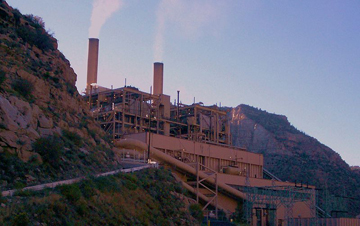Coal truck in western China. Photo by: Rhett A. Butler.
Global carbon dioxide (CO2) emissions from industrial sources are set to hit a new record high this year according to a new analysis by Global Carbon Project. The analysis in Nature Climate Changes predicts that CO2 emissions will rise another 2.6 percent, hitting 35.6 billion tonnes. The scientists warn that such steep climbs in global emissions year-after-year means that the door is rapidly closing on a global agreement to keep temperatures from rising 2 degree Celsius (3.6 degrees Fahrenheit) above pre-industrial levels.
“With emissions continuing to grow, it’s as if no-one is listening to the entire scientific community,” co-author Corinne Le Quéré, director of the Tyndall Centre for Climate Change Research, said in a statement. “I am worried that the risks of dangerous climate change are too high on our current emissions trajectory.”
The analysis found that CO2 emissions jumped 3 percent in 2011, largely due to ongoing emissions growth in China. China’s emissions, which are now the largest in the world, grew an astounding 9.9 percent in 2011. India, another rising emitter, grew 7.5 percent. A recent study found that between both countries, India and China have proposed 818 new coal-fired plants. However, per capita both country’s emissions remain below those in the EU and the U.S.
 Castle Gate coal-fired power plant in Utah. Nearly half of the US’s electricity is from coal, the most carbon intensive energy. Photo by: David Jolley. |
Unlike in China and India, emissions declined in the EU and the U.S. last year. Due in various parts to the economic recession, natural gas replacing coal, and continuing growth in renewables, U.S. emissions fell 1.8 percent in 2011. EU emissions fell 2.8 percent.
China surpassed the U.S. as the world’s number one polluter in 2006. As of last year, the country accounted for 28 percent of the world’s total CO2 emissions from industry, the U.S. for 16 percent, the EU for 11 percent, and India for 7 percent.
“Unless large and concerted global mitigation efforts are initiated soon, the goal of remaining below 2C will soon become unachievable,” reads the paper.
The researchers argues that steep cuts in global greenhouse emissions are needed by 2020 if the world is to have any chance of averting dangerous global climate change. However, governments at the UN Climate Summit in Doha, Qatar this week are discussing a global climate agreement that would be forged in 2015 and not implemented until 2020—too late to have any real chance of keeping the 2 degree Celsius pledge, according to scientists.
“With the pathways we are on with intensive fossil fuels we are looking at 4, 5 or even 6 [degree Celsius warming],” Le Quéré added. “We need a radical plan.”
A recent report by the World Bank painted an apocalyptic picture of a world that has warmed by 4 degree Celsius, including rising sea levels, coral reefs dissolving due to ocean acidification, worsening extreme weather across the world with today’s heatwaves becoming the norm, high risk to agriculture, and a massive decline in the world’s species along with other impacts.
On the plus side the Nature Climate Changes paper argues that some European countries (namely Belgium, Denmark, France, Sweden, and the UK) have seen emissions fall by as much as 5 percent annually over decades due to “energy transitions” to nuclear and renewable energy.
“Scaling up similar energy transitions across more countries can kick-start global mitigation with low costs,” says lead author Glen Peters with the Centre for International Climate and Environmental Research in Norway. “To deepen and sustain these energy transitions in a broad range of countries requires aggressive policy drivers.”
However, calls for a more aggressive response at the UN Climate Summit have so far fallen on deaf ears.
CITATION: G.P. Peters, R.M. Andrew, T. Boden, J.G. Canadell, P. Ciais, C. Le Quéré, G. Marland, M.R. Raupach, C. Wilson. The mitigation challenge to stay below two degrees. Nature Climate Change. 2012.
Related articles
Greenland and Antarctica ice melt accelerating, pushing sea levels higher

(12/03/2012) A massive team of scientists have used multiple methods to provide the best assessment yet of ice loss at the world’s poles, including Greenland and a number of Antarctic ice sheets. Their findings—that all major ice sheets are shrinking but one; that ice loss is speeding up; and that this is contributing to the rise in sea levels—add more evidence to the real-time impacts from global climate change. Melting ice sheets at the poles have raised sea levels 11.1 millimeters, or about 20 percent of observed sea level rise, in the past twenty years, according to the landmark study in Science.
Watery world: sea level rising 60 percent faster than predicted
(11/28/2012) Sea levels are rising 60 percent faster than Intergovernmental Panel on Climate Change (IPCC) has estimated, according to a new study in the open access Environmental Research Letters. In addition to imperiling coastal regions and islands, global sea level rise is worsening the damage inflicted by extreme weather such as Hurricane Sandy, which recently brought catastrophic flooding to the New Jersey coast and New York City.
Organic farming keeps carbon out of the atmosphere

(11/28/2012) With the worst effects of climate change, we are seeing how pollution hurts both human health and the environment but there is good news: a new study shows that organic farming stores more greenhouse gases in the soil than non-organic farming. By switching to organic methods, many farmers across the globe may be helping to solve the climate crisis at the same time as they improve soil quality and avoid the use of pesticides.
Hopes pinned on Obama again as Doha Climate Summit opens

(11/26/2012) A number of observers have expressed hope that the Obama Administration, fresh from a re-election victory in the U.S., will take a more active and ambitious role at this year’s UN Climate Summit, held in Doha, Qatar. The summit opens amid fresh—and increasingly dire—warnings over climate change from the World Bank, the International Energy Agency, and the UN itself.
China and India plan 818 new coal plants
(11/26/2012) Even as the clamor to reduce greenhouse gas emissions reaches a new high—echoed recently by such staid institutions as the World Bank and the International Energy Agency (IEA)—a new analysis by the World Resources Institute (WRI) finds that 818 new coal-fired plants are under proposal in China and India. In all 1,199 new coal-fired plants are currently planned worldwide, according to the report, totaling 1.4 million megawatts of energy.
As Doha Climate Summit kicks off, more ambitious cuts to greenhouse gas emissions needed
(11/26/2012) As the 18th meeting of the UN Framework Convention on Climate Change (UNFCCC) kicks off this morning in oil and gas rich Qatar, the world body warns that much more ambitious greenhouse gas cuts are needed to keep catastrophic climate change at bay. A new report by the UN Environment Program (UNEP) and the European Climate Foundation finds that even if all current emissions pledges are kept, the world will still spew 8 billion tonnes of CO2 equivalent above what is needed by 2020, putting the globe on a fast-track to dangerous climate change.
Forests worldwide near tipping-point from drought

(11/23/2012) Forests worldwide are at ‘equally high risk’ to die-off from drought conditions, warns a new study published this week in the journal Nature. The study, conducted by an international team of scientists, assessed the specific physiological effects of drought on 226 tree species at 81 sites in different biomes around the world. It found that 70 percent of the species sampled are particularly vulnerable to reduction in water availability. With drought conditions increasing around the globe due to climate change and deforestation, the research suggests large swathes of the world’s forests — and the services they afford — may be approaching a tipping point.
Hotter and hotter: concentrations of greenhouse gases hit another new record
(11/20/2012) As expected, greenhouse gas concentrations in the Earth’s atmosphere hit another record last year, according to a new UN World Meteorological Organization (WMO). The increasing concentrations of greenhouse gases means that radiative forcing—changes in the atmosphere’s energy balance that leads to warming—has jumped 30 percent in the last twenty years.
World Bank: 4 degrees Celsius warming would be miserable

(11/20/2012) A new report by the World Bank paints a bleak picture of life on Earth in 80 years: global temperatures have risen by 4 degrees Celsius spurring rapidly rising sea levels and devastating droughts. Global agriculture is under constant threat; economies have been hampered; coastal cities are repeatedly flooded; coral reefs are dissolving from ocean acidification; and species worldwide are vanishing. This, according to the World Bank, is where we are headed even if all of the world’s nations meet their pledges on cutting greenhouse gas emissions. However, the report also notes that with swift, aggressive action it’s still possible to ensure that global temperatures don’t rise above 4 degrees Celsius.